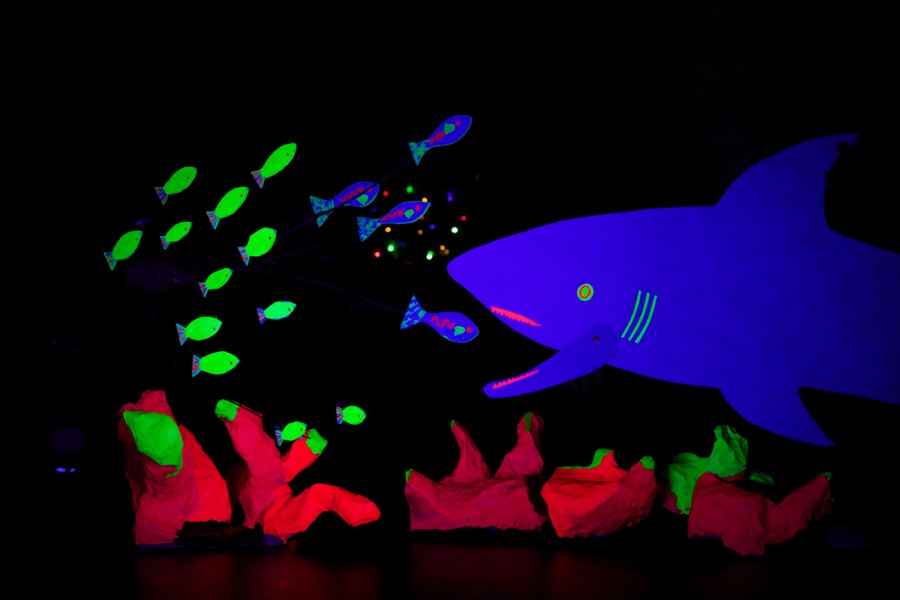Imagining Autism is a creative and practice-based approach to working with autistic children. Its roots are in drama and play-based methods that are in tune with the individual child’s sensory preferences and interests. It engages participants through imaginary journeys into fantasy settings using puppetry, objects, light, sound and digital media. Through intensive interaction and improvisation we co-create fantasy environments in which participants and facilitators find new ways of connecting with the world and each other. The approach complements other practice based drama methods that are used increasingly in autism research. In Imagining Autism the emphasis is on following the cues of participants, rather than teaching social scripts. Each child is recognised as having a spectrum of capabilities and differences. As well as being successfully evaluated by psychologists and published in leading journals across disciplines, the potential of the methods for supporting diagnosis has been the subject of a PhD study (Hannah Newman, 2018): ‘Re-Imagining Autism: How drama environments can aid the diagnosis and understanding of autism.’
There have been three phases to the project:
- Phase 1: Pilot project and Imagining Autism AHRC grant (2010-2014)
- Phase 2: Autism Re-Imagined: Creative Resources for Schools and Communities, public engagement and AHRC Follow-on funding (2015-2018)
- Phase 3: Playing A/Part: Investigating the experiences of autistic girls through drama, interactive media and participatory arts AHRC grant (2018 to 2022), a project exploring the identities and experiences of autistic girls, women and marginalised gender identities through participatory creative practices
Pilot Project 2010
The origins of the project were the initiative of two drama lecturers (Nicola Shaughnessy and Melissa Trimingham), both of whom have autistic children. Their personal experience of using play-based approaches at home led to conversations with psychologists on the potential of drama as a research tool for working with autistic children. In 2010, they began working in a local special school (St Nicholas, Canterbury) with seed funding from Kent “Ideas factory” to run interactive drama workshops using puppetry and play to engage with autistic children, many of whom had minimal language. The development of the ‘pod’, a tent-like structure containing a series of themed multi-sensory scenic environments emerged in the context of a classroom environment. Having received Kent’s Innovative Project of the Year award (2011), the researchers successfully applied to the Arts and Humanities Research Council for a 3-year programme to develop the work in local schools and to evaluate the effectiveness of the methods.
Imagining Autism, AHRC, 2011-2014
The original team for the project were Professor Nicola Shaughnessy (Principal Investigator), Dr Melissa Trimingham (Drama), Professor Julie Beadle-Brown (Tizard Centre) and Professor David Wilkinson (Psychology).
During Autumn 2011, the project team (performers, documenter, technician) created the materials for a series of participatory, immersive installations as environments for performance research.
From January to December 2012, the project team worked with autistic children aged 7-11 in three special Schools across Kent:
- Spring 2012: St Nicholas School, Canterbury
- Summer 2012: Laleham Gap, Broadstairs
- Autumn 2012: Helen Allison School, Meopham
During this period psychologists also worked with the children to evaluate their responses using mixed methods.
Participants were 22 children aged 7-12. Working with two small groups in each school (4-5 children) the team ran 10 weekly 45 minute workshops spending one term in each school. Each participant experienced 10 sessions. The portable ‘pod’ was developed as an immersive environment with five themed settings rotating throughout the term (Forest, Underwater, Arctic, Outer Space, Under the City).
The evaluation by psychologists produced evidence that the drama workshops produced statistically significant changes in key areas.
Results overview
At the immediate follow-up, all 22 children improved on at least one measure. Of the 6 who improved on ADOS social interaction scores, 5 also improved on three or more other measures. Among the other measures, the most significant changes were seen in the number of facial expressions the children recognised. 4 out of 6 children maintained the changes in social interaction on the ADOS at 3 months post-intervention with 3 showing maintenance at 9 months. All children maintained or showed increased changes in emotion recognition at follow up – between 5 months and 1 year after post-intervention. The majority of children maintained these improvements at follow-up (between 5 and 12 months post-intervention).
Autism Re-Imagined, AHRC, 2015-2018
This project is an extension of the original research through a progamme of public engagement and has been funded by the University Kent, the National Lottery and the AHRC. It is a collaboration with autistic community advocates and artists. It consists of a programme of training workshops and resources for a wide range of professionals and carers. The Follow-on funding project produced a limited edition “PopPupPod”, a specially designed creative box for use in the school or home. This is the basis for the iA online resources. We also have an Autistic Community Café tool kit for local groups to run their own events. We continue to offer a variety of training, workshop activities and touring pod residencies.
Playing A/Part: Autistic Girls, Identities and Creativity, AHRC (2018 to 2022)
Playing A/Part emerged from Imagining Autism research, and is an interdisciplinary project, exploring the identities and experiences of autistic girls and adolescents through creative and participatory research. It is a collaboration between the universities of Kent and Surrey, involving academics in drama, media arts and psychology. Funded by the Arts and Humanities Research Council, the project team includes a steering group of autistic women and a multidisciplinary advisory board. By offering participants (aged 11-16) the opportunity to take part in a range of creative participatory activities we aim to gain insights into how autistic girls and adolescents experience themselves and their world.
